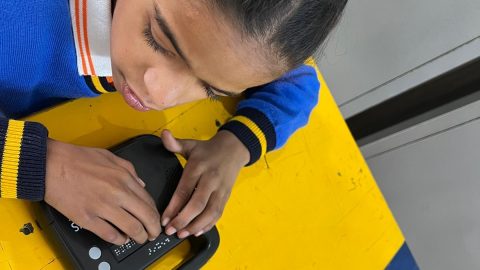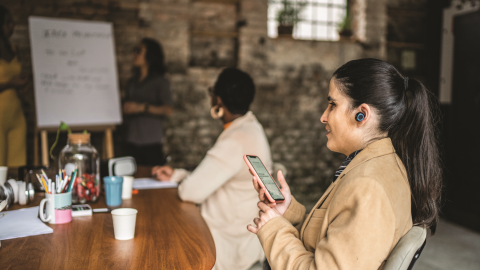Looking back at 10 years of learning at the annual Ability Summit
Today kicks off the 10th Microsoft Ability Summit! With over 80 speakers, 22 breakout sessions, 20+ non-profit organizations, and product fair demos over two days, this is our first all-virtual summit that is fully open to the public. We’re excited to welcome speakers from Microsoft, industry and members of the accessibility and disability communities — many of whom have been alongside us this last decade and whose feedback has made the journey of accessibility possible.
The Ability Summit started in 2010 with a simple premise: to bring together employees with disabilities to share their best practices, pain points, and dreams. While our employee disability groups have been around since the 90’s, the Microsoft Disability Employee Resource Group was in its infancy at the time. I remember being as nervous then as I am today! Would there be value? Would people find the similarities that I was seeing across each of the groups? Would we walk away frustrated or excited? Approximately 80 people attended throughout the course of the short one-day event, and each of them said to me on the way out of the door “Jenny, we must do this again.” So, we did.
The goals of the Ability Summit have evolved over the years but remained true at the core. To bring together people with disabilities, experts in their domains, along with designers, engineering, marketeers, HR professions and nerds together to talk, share, connect and learn how we Build, Imagine, Include and Empower. To identify where we can speed up implementation of accessibility and innovation for people with disabilities – both in the company and outside of the company – on the pathway to driving for a more inclusive society. Lastly, to create best practice in how to build an accessible and inclusive event. Last year 2,500 people joined us for two days, this year – well, we’re about to find out!
Above all else, the Ability Summit has taught us the critical importance of collaboration. It’s the key to accelerating our accessibility journey. Its why we host this annual event, and it’s also why are sharing the Microsoft Accessibility Evolution Model (AEM). Many have asked in the last few years what ‘secret sauce’ has powered Microsoft’s approach to accessibility and inclusion. There is no secret sauce, but we do manage accessibility like a business. The AEM is a maturity model built on the foundation of two existing models – one from Carnegie Mellon, and the other from accessibility specialists at Level Access. The Microsoft Accessibility Leadership Team, which spans the breadth of the company, expanded on the wisdom of these models by creating a series of dimensions with five levels of maturity. We leverage the structure to gain an understanding of our progress and build upon the dimension definitions as our learning grows. It’s a cultural model that starts with inclusion of people with disabilities, strives for inclusive design in product development, and emphasizes the skilling of employees on about accessibility and importance of authentic representation in sales, marketing, and accessibility supplier/procurement.
We also learned the importance of disability and accessibility education. Last year we created an Accessibility in Action Badge for our employees to help shine a spotlight on how technology can empower everyone. After receiving great feedback, we created a similar accessibility in action certification for other employers, nonprofits, and consumers to take alongside our employees. Get your own badge and complete the accessibility fundamentals learning path today!
During this time, it’s especially crucial to adapt to listen to feedback and to insight from the community. Over the last several weeks we have been responding to questions in a series of blogs that highlight accessibility hints, tips, and product features that can power you to work, learn and play in the stay-at-home world. We’ve had a 175% increase in calls to our Disability Answer Desk, from customers looking for assistance from experts on accessibility. We’ve also seen a huge uptick in the use of AI-powered accessibility tools, such as Immersive Reader and captioning in Office 365. While AI captions do not replace human provided captions (CART) they do offer independence, flexibility and strong quality captions thanks to the AI and machine learning behind them. I’m thrilled to share that Microsoft Teams Free edition will soon support live captions, allowing everyone to give them a try. Just last week, Microsoft Edge shared that they have committed over 150 changes on accessibility features into their open source project with the support of the Google Chrome team, and recently embedded features such as Immersive Reader, Picture Dictionary, Microsoft Translator , Read aloud and more. We also highlighted new accessibility functions coming to Windows 10, including Narrator and Magnifier improvements to provide users who are blind or low vision a better experience across applications.
One project that particularly excites me is Project Tokyo, which leverages AI and AR with the power of HoloLens to power children who are blind and low vision to develop social interaction skills, giving these kids the understanding of not just ‘who’ is at the dinner table but where, their expressions and more. Its research and early, but a beautiful illustration of everything Ability Summit stands for – bringing together people with disabilities with experts to open doors with technology.
Excited to get this show on the road – virtually! We’ve been moving fast these last few weeks to pivot to a virtual event and incredibly grateful for the support of Microsoft Teams to power this year’s summit as well as all of the non-profits, companies and speakers who will be joining us. While registration is now closed, videos will be posted on the Microsoft Enable YouTube channel!
Thank you for powering our journey, for keeping us grounded and motivated. If you need any assistance at any time, remember Disability Answer Desk is open 24/7 and all information on accessibility is at www.microsoft.com/accessibility.
Look forward to seeing how we can Include, Build, Imagine, Empower people with disabilities around the world – together. Let’s get this party started!








